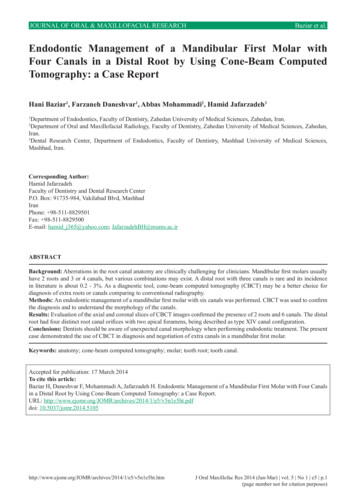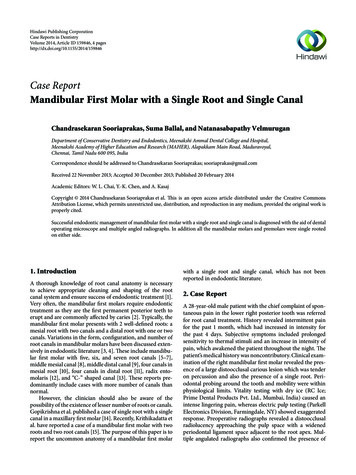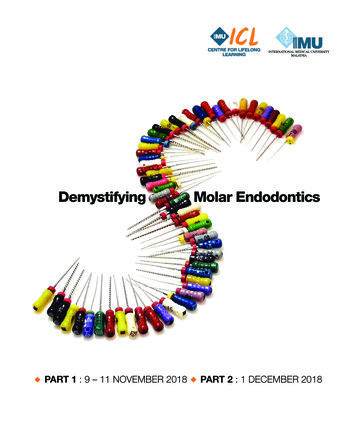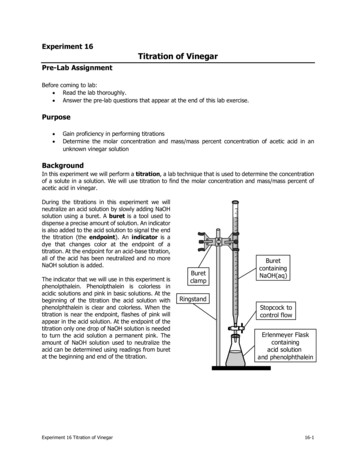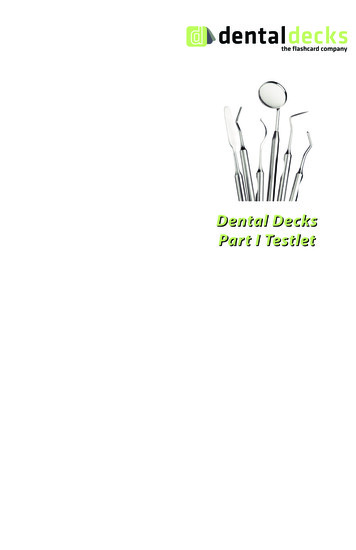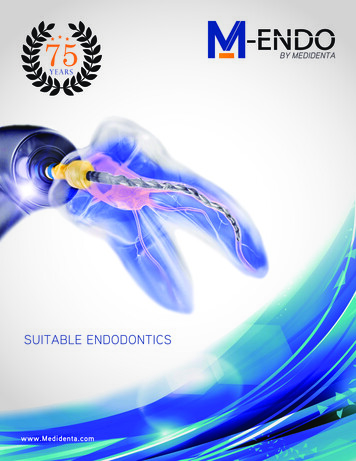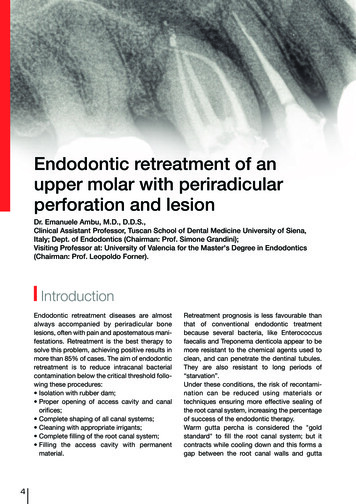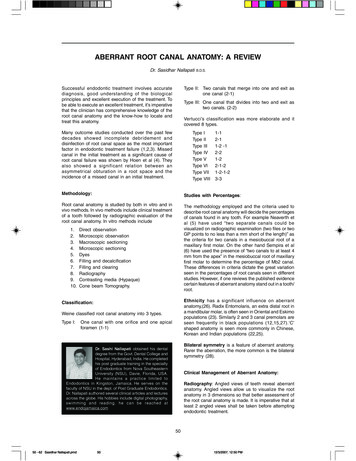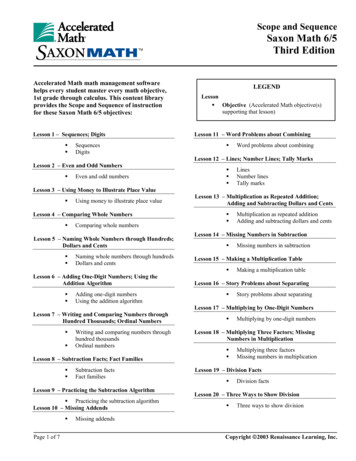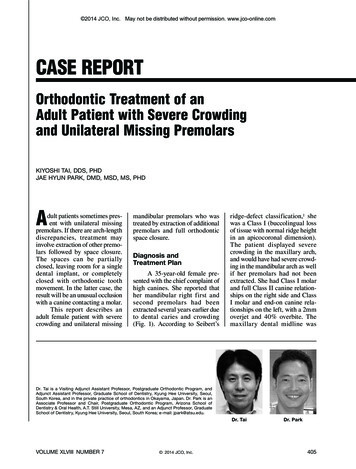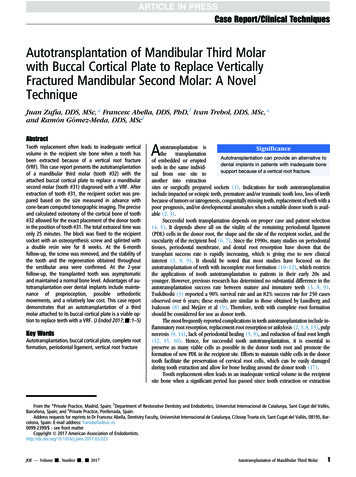
Transcription
Case Report/Clinical TechniquesAutotransplantation of Mandibular Third Molarwith Buccal Cortical Plate to Replace VerticallyFractured Mandibular Second Molar: A NovelTechniqueJuan Zuf ıa, DDS, MSc,* Francesc Abella, DDS, PhD,† Ivan Trebol, DDS, MSc,*and Ram on G omez-Meda, DDS, MSc‡AbstractTooth replacement often leads to inadequate verticalvolume in the recipient site bone when a tooth hasbeen extracted because of a vertical root fracture(VRF). This case report presents the autotransplantationof a mandibular third molar (tooth #32) with theattached buccal cortical plate to replace a mandibularsecond molar (tooth #31) diagnosed with a VRF. Afterextraction of tooth #31, the recipient socket was prepared based on the size measured in advance withcone-beam computed tomographic imaging. The preciseand calculated osteotomy of the cortical bone of tooth#32 allowed for the exact placement of the donor toothin the position of tooth #31. The total extraoral time wasonly 25 minutes. The block was fixed to the recipientsocket with an osteosynthesis screw and splinted witha double resin wire for 8 weeks. At the 6-monthfollow-up, the screw was removed, and the stability ofthe tooth and the regeneration obtained throughoutthe vestibular area were confirmed. At the 2-yearfollow-up, the transplanted tooth was asymptomaticand maintained a normal bone level. Advantages of autotransplantation over dental implants include maintenance of proprioception, possible orthodonticmovements, and a relatively low cost. This case reportdemonstrates that an autotransplantation of a thirdmolar attached to its buccal cortical plate is a viable option to replace teeth with a VRF. (J Endod 2017;-:1–5)Key WordsAutotransplantation, buccal cortical plate, complete rootformation, periodontal ligament, vertical root fractureAutotransplantation isSignificancethe transplantationAutotransplantation can provide an alternative toof embedded or erupteddental implants in patients with inadequate boneteeth in the same individsupport because of a vertical root fracture.ual from one site toanother into extractionsites or surgically prepared sockets (1). Indications for tooth autotransplantationinclude impacted or ectopic teeth, premature and/or traumatic tooth loss, loss of teethbecause of tumors or iatrogenesis, congenitally missing teeth, replacement of teeth with apoor prognosis, and/or developmental anomalies when a suitable donor tooth is available (2, 3).Successful tooth transplantation depends on proper case and patient selection(4, 5). It depends above all on the vitality of the remaining periodontal ligament(PDL) cells in the donor root, the shape and the site of the recipient socket, and thevascularity of the recipient bed (6, 7). Since the 1990s, many studies on periodontaltissues, periodontal membrane, and dental root resorption have shown that thetransplant success rate is rapidly increasing, which is giving rise to new clinicalinterest (3, 8, 9). It should be noted that most studies have focused on theautotransplantation of teeth with incomplete root formation (10–12), which restrictsthe applications of tooth autotransplantation to patients in their early 20s andyounger. However, previous research has determined no substantial difference in theautotransplantation success rate between mature and immature teeth (3, 8, 9).Tsukiboshi (3) reported a 90% survival rate and an 82% success rate for 250 casesobserved over 6 years; these results are similar to those obtained by Lundberg andIsaksson (8) and Mej are et al (9). Therefore, teeth with complete root formationshould be considered for use as donor teeth.The most frequently reported complications in teeth autotransplantation include inflammatory root resorption, replacement root resorption or ankylosis (2, 3, 8, 13), pulpnecrosis (9, 14), lack of periodontal healing (5, 9), and reduction of final root length(12, 15, 16). Hence, for successful tooth autotransplantation, it is essential topreserve as many viable cells as possible in the donor tooth root and promote theformation of new PDL in the recipient site. Efforts to maintain viable cells in the donortooth facilitate the preservation of cervical root cells, which can be easily damagedduring tooth extraction and allow for bone healing around the donor tooth (17).Tooth replacement often leads to an inadequate vertical volume in the recipientsite bone when a significant period has passed since tooth extraction or extractionFrom the *Private Practice, Madrid, Spain; †Department of Restorative Dentistry and Endodontics, Universitat Internacional de Catalunya, Sant Cugat del Vall es,Barcelona, Spain; and ‡Private Practice, Ponferrada, Spain.Address requests for reprints to Dr Francesc Abella, Dentistry Faculty, Universitat Internacional de Catalunya, C/Josep Trueta s/n, Sant Cugat del Vall es, 08195, Barcelona, Spain. E-mail address: franabella@uic.es0099-2399/ - see front matterCopyright ª 2017 American Association of .03.023JOE — Volume -, Number -, - 2017Autotransplantation of Mandibular Third Molar1
Case Report/Clinical Techniquesresulting from a periodontal problem or a vertical root fracture (VRF).The aim of this report was to present an atraumatic and precise surgicaltechnique guided by cone-beam computed tomographic (CBCT) imaging for osteotomy preparation of donor sites. The case report focuses onthe autotransplantation of a mandibular third molar still attached to itsbuccal cortical plate to replace a mandibular second molar with a VRF.Case ReportIn May 2015, a 35-year-old woman was referred for evaluation ofher mandibular right second molar (tooth #31). The medical historywas noncontributory. The patient’s chief complaint was of a purulentdischarge from tooth #31 and pain on biting over the preceding4 months. Clinical examination revealed that it had a restoration of resincomposite and was sensitive to vertical percussion (Fig. 1A). At the timeof the exploration, a draining sinus tract was not evident, and toothmobility was within physiologic limits. Periodontal probing revealedlocal pocketing almost to the apex on the mesiobuccal and distobuccalregion of tooth #31 (Fig. 1B).Radiographic examination revealed an extensive furcation, crestal,and periapical bone resorption of tooth #31 (Fig. 1C). These clinical,periodontal, and radiographic findings led us to suspect a VRF. Duringthis appointment, an interdisciplinary treatment plan was formulated;the patient was informed that tooth #31 had a questionable long-termprognosis because of the possible VRF. A small-volume CBCT imagewas taken (Planmeca 3Ds; Planmeca Oy, Helsinki, Finland) to revealthe pattern of bone destruction, the involvement of the buccal corticalplate, and a possible line of fracture. A complete loss of the buccalcortical plate was observed in the axial, sagittal, and coronal sections(Fig. 1D–F). The axial images showed an extensive bone resorptionin both the buccal and lingual surface (Fig. 1D). However, no radiolucent line was detected compatible with a VRF.Clinically and radiographically, the mandibular third molar (tooth#32) was completely erupted and positioned within the dental arch andwithout an antagonist, making it possible for tooth autotransplantation.The treatment plan included extraction of fractured tooth #31 and autotransplantation of tooth #32 with the buccal cortical plate in order tovertically regenerate the bone defect. Informed consent was obtainedfor the treatment.Endodontic treatment of tooth #32 was completed preoperatively(48 hours before autotransplantation) to reduce the extraoral time. Thevolumetric size of the donor tooth was analyzed from CBCT images tocalculate the suitability of the transplant as well as the buccal corticalsize to be taken.Surgical ProcedureAfter local anesthesia, a mucoperiosteal flap surrounding teeth#31 and #32 was raised. As we expected, a full dehiscence of the buccalplate was observed in tooth #31, and a fracture line was visible in the 2exposed roots, confirming a definitive diagnosis of VRF (Fig. 2A–C). After extraction, the recipient socket was prepared with a surgical roundbur with copious saline irrigation based on the size measured inadvance on CBCT imaging. All the granulation tissue in the extractionsocket defect was thoroughly cleaned (Fig. 2D–F). To reduce the injuryto the PDL of the donor tooth and regenerate the bone defect in therecipient socket, tooth #32 was extracted carefully with the attachedbuccal cortical plate. A precise and calculated osteotomy of the corticalbone of tooth #32 was made (Fig. 3A–D). This allowed the exact placement of the donor tooth in the position of tooth #31 and completelyreplaced the recipient socket. The tooth was stored in physiologic saline–soaked gauze during the extraoral procedure. The block was fixedto the recipient socket with an osteosynthesis screw (Fig. 3E). Then, thetransplanted tooth was splinted with a double resin wire splint (buccalFigure 1. (A) A 35-year-old woman was referred for evaluation of her mandibular right second molar (tooth #31). (B) Periodontal probing revealed local pocketing almost to the apex on the mesiobuccal and distobuccal region of tooth #31. (C) Tooth #31 with endodontic treatment and clinical signs of VRF. Note theextensive furcation, crestal, and periapical bone resorption. (D) The reconstructed axial CBCT (Planmeca 3Ds) images showed an extensive bone resorption in thebuccal and lingual surface. (E) The sagittal view. (F) Coronal CBCT images revealed a complete loss of the buccal cortical plate of tooth #31. The fracture was notvisible on either imaging modality.2Zuf ıa et al.JOE — Volume -, Number -, - 2017
Case Report/Clinical TechniquesFigure 2. (A) The suspected VRF was only confirmed during the surgical flap. (B) Extraction of tooth #31. (C) A fracture line was visible in the mesial and distalroot. (D) All the granulation tissue in the socket defect was cleaned. (E and F) The recipient socket preparation was guided according to the preoperative CBCTimage.and lingual) for 8 weeks (Fig. 3F and G). The splint was passive andsemirigid, maintaining physiologic tooth mobility. It was not necessaryto correct any occlusal interference because the clinical crown of tooth#32 was shorter in length than the crown of tooth #31.The patient was examined every month during the first year andthen at 2 years after surgery. At the 6-month follow-up, the screw wasremoved, and the stability of the tooth and the regeneration obtainedthroughout the vestibular area were verified (Fig. 4A). After 2 months,a lithium disilicate overlay with a circumferential adhesive ferrule effectwas performed (Fig. 4B–D). At the 2-year follow-up, the transplantedtooth was asymptomatic and maintained a normal bone level(Fig. 4E). The radiographs revealed no replacement or inflammatoryroot resorption of the transplant. No bone furcation defect wasobserved, indicating that there was no vertical resorption of the bonefragment (Fig. 4F).DiscussionA VRF in endodontically treated teeth is 1 of the most frustratingcomplications of root canal treatment, which results in tooth or rootextraction (18–20). VRF is a longitudinally oriented fracture of theFigure 3. (A and B) A precise and calculated osteotomy guided by the CBCT image of the cortical bone of tooth #32. (C) A comparison of size between teeth #31and #32. (D and E) The block was fixed to the recipient socket with an osteosynthesis screw. (F) A double resin wire splint. (G) A periapical radiograph confirmingthe correct position of the tooth after replantation and splinting. The transplanted tooth was positioned below the occlusal plane.JOE — Volume -, Number -, - 2017Autotransplantation of Mandibular Third Molar3
Case Report/Clinical TechniquesFigure 4. (A) Removal of the osteosynthesis screw. Note the bone regeneration obtained throughout the vestibular area. (B) Details of the overlay preparation ofthe transplanted tooth. (C) The laboratory painted lithium disilicate wax-up. (D) Try-in and small occlusal check of the restoration without rubber dam isolation.(E) Lithium disilicate painted overlay after the adhesive cementation. (F) The 2-year radiographic follow-up showing normal bone contour around the tooth.root that originates from its apical end and propagates coronally and isdefined as 1 of the crack types (21). In many cases of tooth replacement, an inadequate vertical volume in the recipient site bone isobserved when a significant period has passed after tooth extractionor when a tooth has been extracted because of a periodontal problemor a VRF. When aVRF is diagnosed, the inflammation in the supportingtissues leads to periodontal breakdown followed by the development ofa deep osseous defect and resorption of the bone facing the root fracture (19). Tsesis et al (22) concluded that a definitive diagnosis of VRFcan only be reached through a flap surgical procedure, after a toothextraction, or radiographically when there is a clearly discernable separation of fractured root segments. In the presented case, a full dehiscence of the buccal plate with bone resorption extending into theinterproximal area was observed after raising a mucoperiosteal flap.Advantages of autotransplantation over dental implants includemaintenance of proprioception, possible orthodontic movements, relatively low cost, and pulpal regeneration with immature teeth (3, 23).According to some studies (24–26), bone regeneration can beinduced at the recipient site after transplantation when the PDL cellsof the donor tooth root are preserved. Theoretically, both horizontaland vertical bone growth is possible (27), but few cases have shownvertical growth in the case of mature third molar autotransplantation(17, 28). Zhang et al (29) reported that the regenerative potential ofPDL cells is reduced with aging, which might interfere with the normaladaptation of the donor tooth on the recipient site. Hence, we preferredto use an atraumatic surgical technique and perform an autotransplantation of the mandibular third molar (tooth # 32) with the attachedbuccal cortical plate.The most important factor for the success of autogenous toothtransplantation is the vitality of the PDL attached to the transplantedtooth (27). The PDL is sensitive to pH and osmotic potential, and itsviability is reduced if the extraoral dry time is long (30). In this case,the tooth was held gently at both the crown and root with gauze soakedin physiologic saline. An extraoral time less than 20 minutes is associated with a positive effect on tooth survival (30), which is consistent withthe results of studies on intentional replantation (31, 32). In this casereport, the total extraoral time was only 25 minutes, allowing us to avoidthe application of any solution, such as tetracycline, citric acid, EDTA, orenamel matrix derivative, to the root surface to enhance PDL fiberattachment or prevent ankylosis (33, 34). In this regard, the4Zuf ıa et al.previous measurements we performed using CBCT imaging wereessential to minimize the extraoral time. Another valid option is theuse of computer-aided rapid prototyping models (17, 23, 35).A recent systematic review provided the first evidence of outcomesof autotransplanted teeth with complete root formation (36). Rates offailure, infection-related root resorption, and ankylosis were occasionally observed in autotransplanted teeth with complete root formation.Teeth with fully developed roots are usually endodontically treatedbefore transplantation because revascularization and pulpal healingare less likely to occur (3). In this way, inflammatory proceduresthat could endanger their prognosis are usually prevented (6, 9).ConclusionsAutotransplantation can provide an alternative to the dentalimplant in some patients in whom dental implants become difficultbecause of inadequate bone support and in patients in growing stages.On the basis of this case, an autotransplantation of a third molarattached to its buccal cortical plate is a viable option to replace teethwith VRF.AcknowledgmentsThe authors deny any conflicts of interest related to this study.References1. Natiella JR, Armitage JE, Greene GW. The replantation and transplantation of teeth. Areview. Oral Surg Oral Med Oral Pathol 1970;29:397–419.2. Tsukiboshi M, Andreasen J, Asai Y. Autotransplantation of Teeth. Chicago, IL:Quintessence; 2001. 10–14, 97, 152–167.3. Tsukiboshi M. Autotransplantation of teeth: requirements for predictable success.Dent Traumatol 2002;18:157–80.4. Northway WM, Konigsberg S. Autogenic tooth transplantation. The ‘‘state of the art’’.Am J Orthod 1980;77:146–62.5. Andreasen JO, Paulsen HU, Yu Z, Schwartz O. A long-term study of 370 autotransplanted premolars. Part III. Periodontal healing subsequent to transplantation. Eur JOrthod 1990;12:25–37.6. Nethander G, Skoglund A, Kahnberg KE. Experimental autogenous tooth transplantation in the dog: a comparison between one- and two-stage surgical techniques.Acta Odontol Scand 2003;61:223–9.7. Katayama A, Ota M, Sugito H, et al. Effect of proliferating tissue on transplanted teethin dogs. Oral Surg Oral Med Oral Pathol Oral Radiol Endod 2006;101:e110–8.8. Lundberg T, Isaksson S. A clinical follow-up study of 278 autotransplanted teeth. BrJ Oral Maxillofac Surg 1996;34:181–5.JOE — Volume -, Number -, - 2017
Case Report/Clinical Techniques9. Mej are B, Wannfors K, Jansson L. A prospective study on transplantation of thirdmolars with complete root formation. Oral Surg Oral Med Oral Pathol Oral RadiolEndod 2004;97:231–8.10. Nagori SA, Jose A, Bhutia O, Roychoudhury A. Evaluating success of autotransplantation of embedded/impacted third molars harvested using piezosurgery: a pilotstudy. Acta Odontol Scand 2014;72:846–51.11. Kallu R, Vinckier F, Politis C, et al. Tooth transplantations: a descriptive retrospectivestudy. Int J Oral Maxillofac Surg 2005;34:745–55.12. Bauss O, Zonios I, Rahman A. Root development of immature third molars transplanted to surgically created sockets. J Oral Maxillofac Surg 2008;66:1200–11.13. Akkocaoglu M, Kasaboglu O. Success rate of autotransplanted teeth without stabilisation by splints: a long- term clinical and radiological follow-up. Br J Oral Maxillofac Surg 2005;43:31–5.14. Andreasen JO, Paulsen HU, Yu Z, et al. A long-term study of 370 autotransplantedpremolars. Part II. Tooth survival and pulp healing subsequent to transplantation.Eur J Orthod 1990;12:14–24.15. Kristerson L. Autotransplantation of human premolars. A clinical and radiographicstudy of 100 teeth. Int J Oral Surg 1985;14:200–13.16. Bauss O, Schwestka-Polly R, Hoy L, Kiliaridis S. Influence of orthodontic movementon root length of autotransplanted imma- ture third molars. Eur J Oral Sci 2004;112:12–8.17. Kim S, Lee SJ, Shin Y, Kim E. Vertical bone growth after autotransplantation ofmature third molars: 2 case reports with long-term follow-up. J Endod 2015;41:1371–4.18. Walton RE, Michelich RJ, Smith GN. The histopathogenesis of vertical root fractures.J Endod 1984;10:48–56.19. Tamse A. Vertical root fractures in endodontically treated teeth: diagnostic signs andclinical management. Endod Topics 2006;13:84–94.20. Tamse A, Fuss Z, Lustig J, Kaplavi J. An evaluation of endodontically treated verticallyfractured teeth. J Endod 1999;25:506–8.21. Colleagues for excellence. Cracking the Cracked Tooth Code: Detection andTreatment of Various Longitudinal Tooth Fractures. Chicago, IL: American Association of Endodontics; 2008.22. Tsesis I, Rosen E, Tamse A, et al. Diagnosis of vertical root fractures in endodontically treated teeth based on clinical and radiographic indices: a systematic review.J Endod 2010;36:1455–8.JOE — Volume -, Number -, - 201723. Jang JH, Lee SJ, Kim E. Autotransplantation of immature third molars using a computeraided rapid prototyping model: a report of 4 cases. J Endod 2013;39:1461–6.24. Bright R, Hynes K, Gronthos S, Bartold PM. Periodontal ligament-derived cells forperiodontal regeneration in animal models: a systematic review. J PeriodontalRes 2015;50:160–72.25. Seo BM, Miura M, Gronthos S, et al. Investigation of multipotent postnatal stem cellsfrom human periodontal ligament. Lancet 2004;364:149–55.26. Liu Y, Zheng Y, Ding G, et al. Periodontal ligament stem cell-mediated treatment forperiodontitis in miniature swine. Stem Cells 2008;26:1065–73.27. Andreasen JO. Interrelation between alveolar bone and periodontal ligament repairafter replantation of mature permanent incisors in monkeys. J Periodontal Res1981;16:228–35.28. Plakwicz P, Czochrowska EM, Milczarek A, Zadurska M. Vertical bone growthfollowing third molar to replace a retained mandibular permanent molar: a casereport. Int J Periodontics Restorative Dent 2014;34:667–71.29. Zhang J, An Y, Gao LN, et al. The effect of aging on the pluripotential capacity andregenerative potential of human periodontal ligament stem cells. Biomaterials 2012;33:6974–86.30. Jang Y, Choi Y, Lee SJ, et al. Prognostic factors for clinical outcomes in autotransplantation of teeth with complete root formation: survival analysis for up to 12 years.J Endod 2016;42:198–205.31. Cho SY, Lee Y, Shin SJ, et al. Retention and healing outcomes after intentionalreplantation. J Endod 2016;42:909–15.32. Jang Y, Lee SJ, Yoon TC, et al. Survival rate of teeth with a C-shaped canal after intentional replantation: a study of 41 cases for up to 11 years. J Endod 2016;42:1320–5.33. Zucchelli G, Mele M, Checchi L. The papilla amplification flap for the treatment of alocalized periodontal defect associated with a palatal groove. J Periodontol 2006;77:1788–96.34. Zaman KU, Sugaya T, Hongo O, Kato H. A study of attached and oriented human periodontal ligament cells to periodontally diseased cementum and dentin after demineralizing with neutral and low pH etching solution. J Periodontol 2000;71:1094–9.35. Bae JH, Choi YH, Cho BH, et al. Autotransplantation of teeth with complete root formation: a case series. J Endod 2010;36:1422–6.36. Chung WC, Tu YK, Lin YH, Lu HK. Outcomes of autotransplanted teeth with completeroot formation: a systematic review and meta-analysis. J Clin Periodontol 2014;41:412–23.Autotransplantation of Mandibular Third Molar5
of a mandibular third molar (tooth #32) with the attached buccal cortical plate to replace a mandibular second molar (tooth #31) diagnosed with a VRF. After extraction of tooth #31, the recipient socket was pre-pared based on the size measured in ad
